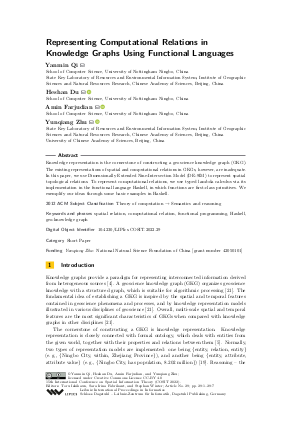Representing Computational Relations in Knowledge Graphs Using Functional Languages (Short Paper)
Authors
Yanmin Qi,
Heshan Du  ,
Amin Farjudian
,
Amin Farjudian  ,
Yunqiang Zhu
,
Yunqiang Zhu 
-
Part of:
Volume:
15th International Conference on Spatial Information Theory (COSIT 2022)
Part of: Series: Leibniz International Proceedings in Informatics (LIPIcs)
Part of: Conference: Conference on Spatial Information Theory (COSIT) - License:
 Creative Commons Attribution 4.0 International license
Creative Commons Attribution 4.0 International license
- Publication Date: 2022-08-22
File

PDF
LIPIcs.COSIT.2022.29.pdf
- Filesize: 0.54 MB
- 7 pages
Document Identifiers
Subject Classification
ACM Subject Classification
- Theory of computation → Semantics and reasoning
Keywords
- spatial relation
- computational relation
- functional programming
- Haskell
- geo-knowledge graph
Metrics
- Access Statistics
-
Total Accesses (updated on a weekly basis)
0PDF Downloads0Metadata Views
Abstract
Knowledge representation is the cornerstone of constructing a GKG. The existing representations of spatial and computational relations in GKGs, however, are inadequate. In this paper, we use DE-9IM to represent spatial topological relations. To represent computational relations, we use typed lambda calculus via its implementation in the functional language Haskell, in which functions are first-class primitives. We exemplify our ideas through some basic examples in Haskell.
Cite As Get BibTex
Yanmin Qi, Heshan Du, Amin Farjudian, and Yunqiang Zhu. Representing Computational Relations in Knowledge Graphs Using Functional Languages (Short Paper). In 15th International Conference on Spatial Information Theory (COSIT 2022). Leibniz International Proceedings in Informatics (LIPIcs), Volume 240, pp. 29:1-29:7, Schloss Dagstuhl – Leibniz-Zentrum für Informatik (2022)
https://doi.org/10.4230/LIPIcs.COSIT.2022.29
BibTex
@InProceedings{qi_et_al:LIPIcs.COSIT.2022.29,
author = {Qi, Yanmin and Du, Heshan and Farjudian, Amin and Zhu, Yunqiang},
title = {{Representing Computational Relations in Knowledge Graphs Using Functional Languages}},
booktitle = {15th International Conference on Spatial Information Theory (COSIT 2022)},
pages = {29:1--29:7},
series = {Leibniz International Proceedings in Informatics (LIPIcs)},
ISBN = {978-3-95977-257-0},
ISSN = {1868-8969},
year = {2022},
volume = {240},
editor = {Ishikawa, Toru and Fabrikant, Sara Irina and Winter, Stephan},
publisher = {Schloss Dagstuhl -- Leibniz-Zentrum f{\"u}r Informatik},
address = {Dagstuhl, Germany},
URL = {https://drops.dagstuhl.de/entities/document/10.4230/LIPIcs.COSIT.2022.29},
URN = {urn:nbn:de:0030-drops-169147},
doi = {10.4230/LIPIcs.COSIT.2022.29},
annote = {Keywords: spatial relation, computational relation, functional programming, Haskell, geo-knowledge graph}
}
Author Details
- School of Computer Science, University of Nottingham Ningbo, China
- State Key Laboratory of Resources and Environmental Information System, Institute of Geographic Sciences and Natural Resources Research, Chinese Academy of Sciences, Beijing, China
Funding
- Zhu, Yunqiang: National Natural Science Foundation of China [grant number 42050101]
References
- John Backus. Can programming be liberated from the von Neumann style? A functional style and its algebra of programs. Commun. ACM, 21(8):613-641, 1978. URL: https://doi.org/10.1145/359576.359579.
- Thomas Bittner, Jonathan P. Bona, and Werner Ceusters. Ontologies of dynamical systems and verifiable ontology-based computation: Towards a Haskell-based implementation of Referent Tracking. In Roberta Ferrario and Werner Kuhn, editors, Formal Ontology in Information Systems - Proceedings of the 9th International Conference, FOIS 2016, Annecy, France, July 6-9, 2016, volume 283 of Frontiers in Artificial Intelligence and Applications, pages 313-327. IOS Press, 2016. URL: https://doi.org/10.3233/978-1-61499-660-6-313.
- Xiaojun Chen, Shengbin Jia, and Yang Xiang. A review: Knowledge reasoning over knowledge graph. Expert Syst. Appl., 141, 2020. URL: https://doi.org/10.1016/j.eswa.2019.112948.
-
Jiaxin Du, Shaohua Wang, Xinyue Ye, Diana S Sinton, and Karen Kemp. GIS-KG: Building a large-scale hierarchical knowledge graph for geographic information science. International Journal of Geographical Information Science, pages 1-25, 2021.

- Antony Galton. Spatial and temporal knowledge representation. Earth Sci. Informatics, 2(3):169-187, 2009. URL: https://doi.org/10.1007/s12145-009-0027-6.
-
Leo S Hsu and Regina Obe. PostGIS in action. Simon and Schuster, 2021.

-
Zhenjiang Hu, John Hughes, and Meng Wang. How functional programming mattered. National Science Review, 2(3):349-370, 2015.

-
Graham Hutton. Programming in Haskell. Cambridge University Press, 2nd edition, 2016.

-
Martin Leinberger, Ralf Lämmel, and Steffen Staab. The essence of functional programming on semantic data. In Programming Languages and Systems - 26th European Symposium on Programming, ESOP 2017, volume 10201 of Lecture Notes in Computer Science, pages 750-776. Springer, 2017.

- Xun-Gui Li and Xia Wei. Soil erosion analysis of human influence on the controlled basin system of check dams in small watersheds of the Loess Plateau, China. Expert Syst. Appl., 38(4):4228-4233, 2011. URL: https://doi.org/10.1016/j.eswa.2010.09.088.
-
Gengchen Mai, Krzysztof Janowicz, Yingjie Hu, Song Gao, Bo Yan, Rui Zhu, Ling Cai, and Ni Lao. A review of location encoding for GeoAI: methods and applications. International Journal of Geographical Information Science, pages 1-35, 2022.

- Eugenio Moggi. Notions of computation and monads. Information and Computation, 93(1):55-92, 1991. URL: https://doi.org/10.1016/0890-5401(91)90052-4.
-
Robert G Raskin and Michael J Pan. Knowledge representation in the Semantic Web for Earth and Environmental Terminology (SWEET). Computers & Geosciences, 31(9):1119-1125, 2005.

-
Ahmet Sayar, Marlon Pierce, and Geoffrey Fox. OGC compatible geographical information systems web services. Indiana Computer Science Report TR610, 2005.

-
Sven Schade, Frank O. Ostermann, and Laura Spinsanti. Functional integration for the observation web. In KEOD 2011 - Proceedings of the International Conference on Knowledge Engineering and Ontology Development, Paris, France, 26-29 October, 2011, pages 498-504. SciTePress, 2011.

-
Syed K Shahzad, Michael Granitzer, and Klause Tochterman. Designing user interfaces through ontological user model: functional programming approach. In 2009 Fourth International Conference on Computer Sciences and Convergence Information Technology, pages 99-104, 2009.

- Christian Strobl. Dimensionally Extended Nine-Intersection Model (DE-9IM). In Encyclopedia of GIS, pages 470-476. Springer, 2017. URL: https://doi.org/10.1007/978-3-319-17885-1_298.
- Philip Wadler. How to declare an imperative. ACM Comput. Surv., 29(3):240-263, 1997. URL: https://doi.org/10.1145/262009.262011.
- Shu Wang, Xueying Zhang, Peng Ye, Mi Du, Yanxu Lu, and Haonan Xue. Geographic Knowledge Graph (GeoKG): A formalized geographic knowledge representation. ISPRS Int. J. Geo Inf., 8(4):184, 2019. URL: https://doi.org/10.3390/ijgi8040184.
-
Yi Zhang, Yong Gao, LuLu Xue, Si Shen, and KaiChen Chen. A common sense geographic knowledge base for GIR. Science in China Series E: Technological Sciences, 51(1):26-37, 2008.

-
Chenghu Zhou, Hua Wang, Chengshan Wang, Zengqian Hou, Zhiming Zheng, Shuzhong Shen, Qiuming Cheng, Zhiqiang Feng, Xinbing Wang, Hairong Lv, et al. Geoscience knowledge graph in the big data era. Science China Earth Sciences, 64(7):1105-1114, 2021.

